Financial Accounting & Reporting: Impact of Regulations on Statements
VerifiedAdded on 2023/05/31
|12
|3292
|118
Essay
AI Summary
This essay discusses and assesses the impact of accounting regulations, specifically Company Law and Accounting Standards in the UK, on the preparation of financial statements, including the statements of comprehensive income, financial position, and cash flow. It evaluates the relevance of these statements to their users, highlighting the role of financial accounting in mitigating agency problems and providing crucial information to stakeholders such as shareholders, lenders, and creditors. The essay emphasizes the importance of accurate financial reporting and the role of accounting standards in ensuring consistency and comparability across companies, referencing specific standards like IAS 14, IAS 7, and IAS 2. It also touches upon the efforts towards global harmonization of accounting standards and the significance of the conceptual framework.
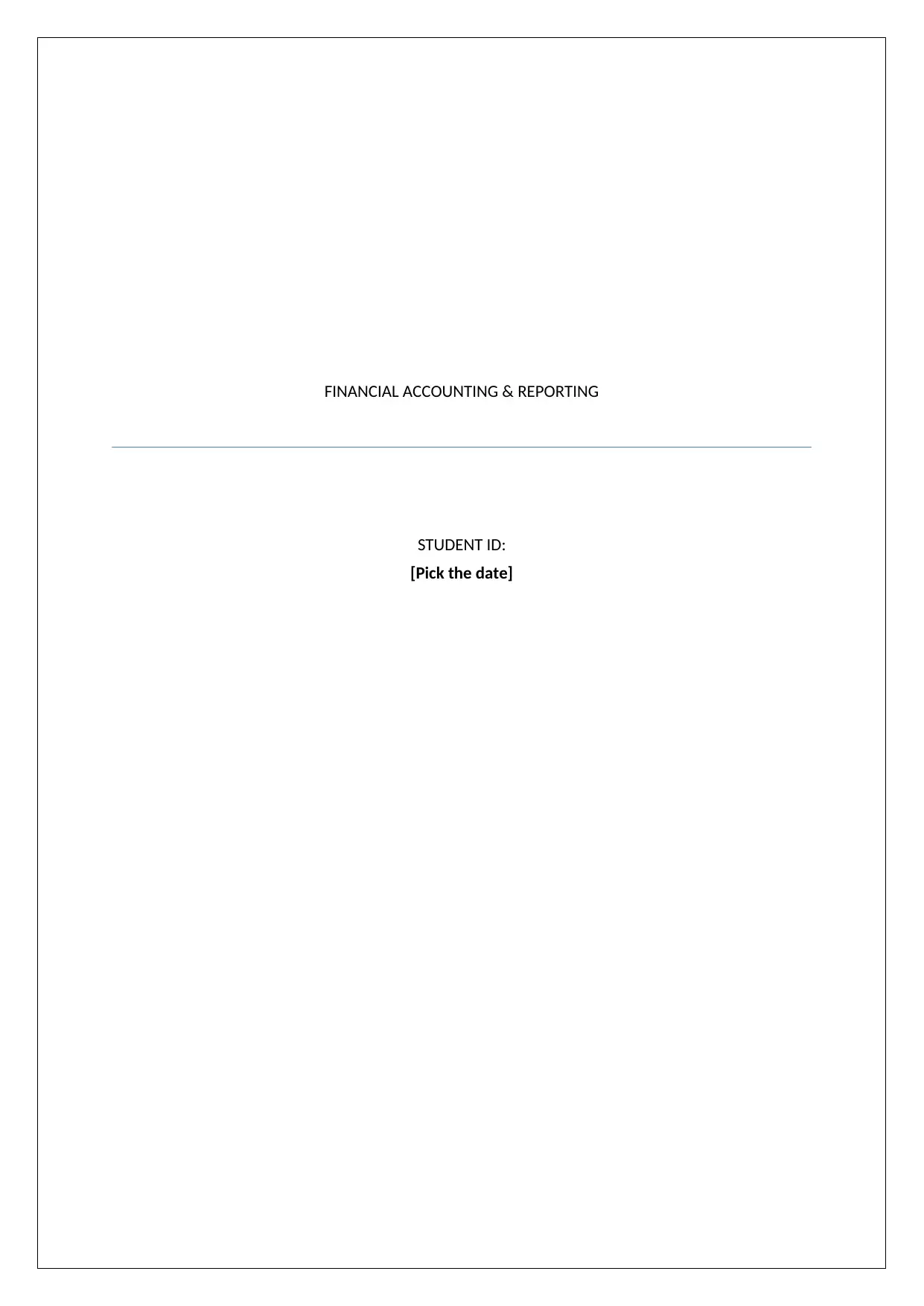
FINANCIAL ACCOUNTING & REPORTING
STUDENT ID:
[Pick the date]
STUDENT ID:
[Pick the date]
Paraphrase This Document
Need a fresh take? Get an instant paraphrase of this document with our AI Paraphraser
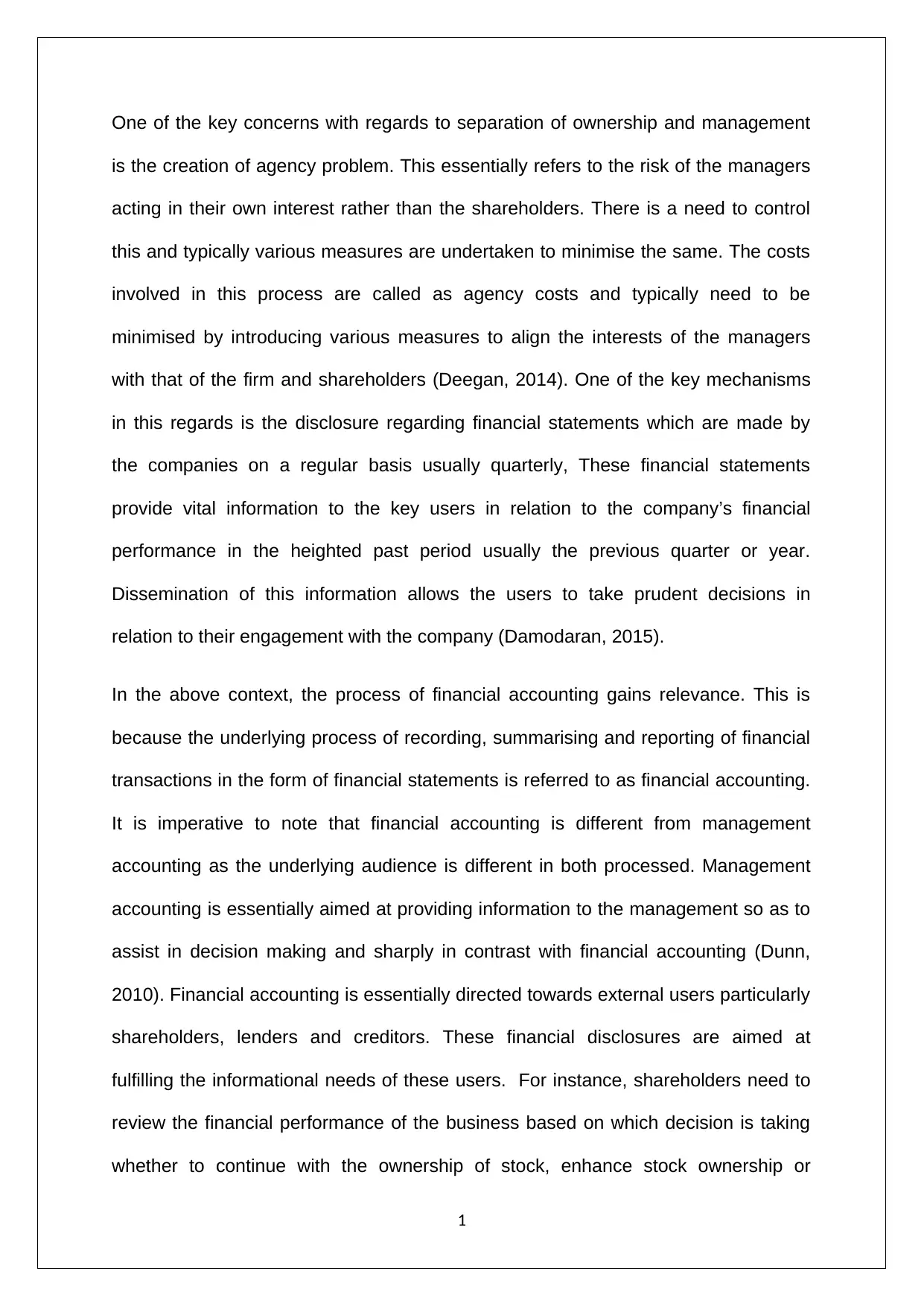
One of the key concerns with regards to separation of ownership and management
is the creation of agency problem. This essentially refers to the risk of the managers
acting in their own interest rather than the shareholders. There is a need to control
this and typically various measures are undertaken to minimise the same. The costs
involved in this process are called as agency costs and typically need to be
minimised by introducing various measures to align the interests of the managers
with that of the firm and shareholders (Deegan, 2014). One of the key mechanisms
in this regards is the disclosure regarding financial statements which are made by
the companies on a regular basis usually quarterly, These financial statements
provide vital information to the key users in relation to the company’s financial
performance in the heighted past period usually the previous quarter or year.
Dissemination of this information allows the users to take prudent decisions in
relation to their engagement with the company (Damodaran, 2015).
In the above context, the process of financial accounting gains relevance. This is
because the underlying process of recording, summarising and reporting of financial
transactions in the form of financial statements is referred to as financial accounting.
It is imperative to note that financial accounting is different from management
accounting as the underlying audience is different in both processed. Management
accounting is essentially aimed at providing information to the management so as to
assist in decision making and sharply in contrast with financial accounting (Dunn,
2010). Financial accounting is essentially directed towards external users particularly
shareholders, lenders and creditors. These financial disclosures are aimed at
fulfilling the informational needs of these users. For instance, shareholders need to
review the financial performance of the business based on which decision is taking
whether to continue with the ownership of stock, enhance stock ownership or
1
is the creation of agency problem. This essentially refers to the risk of the managers
acting in their own interest rather than the shareholders. There is a need to control
this and typically various measures are undertaken to minimise the same. The costs
involved in this process are called as agency costs and typically need to be
minimised by introducing various measures to align the interests of the managers
with that of the firm and shareholders (Deegan, 2014). One of the key mechanisms
in this regards is the disclosure regarding financial statements which are made by
the companies on a regular basis usually quarterly, These financial statements
provide vital information to the key users in relation to the company’s financial
performance in the heighted past period usually the previous quarter or year.
Dissemination of this information allows the users to take prudent decisions in
relation to their engagement with the company (Damodaran, 2015).
In the above context, the process of financial accounting gains relevance. This is
because the underlying process of recording, summarising and reporting of financial
transactions in the form of financial statements is referred to as financial accounting.
It is imperative to note that financial accounting is different from management
accounting as the underlying audience is different in both processed. Management
accounting is essentially aimed at providing information to the management so as to
assist in decision making and sharply in contrast with financial accounting (Dunn,
2010). Financial accounting is essentially directed towards external users particularly
shareholders, lenders and creditors. These financial disclosures are aimed at
fulfilling the informational needs of these users. For instance, shareholders need to
review the financial performance of the business based on which decision is taking
whether to continue with the ownership of stock, enhance stock ownership or
1
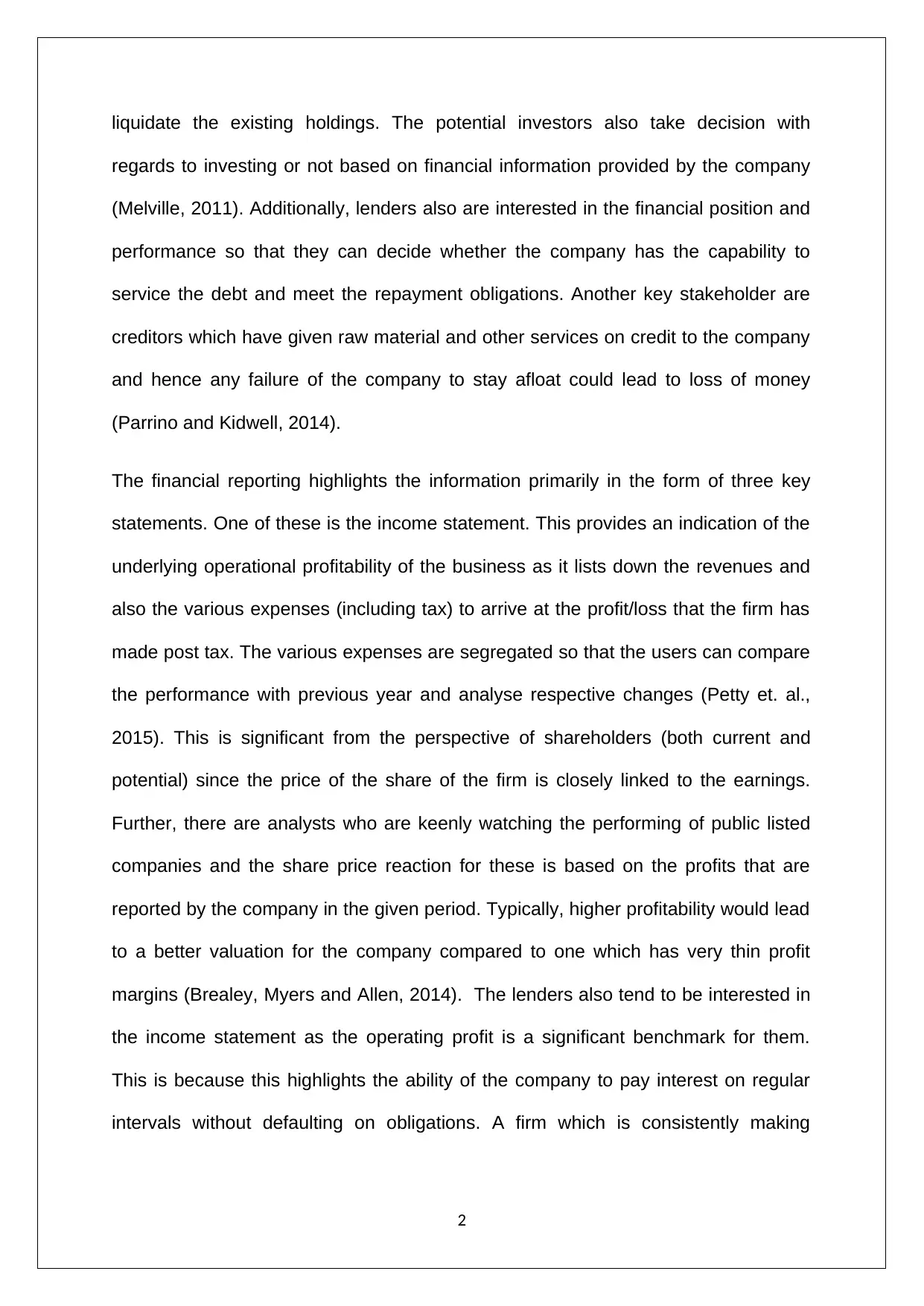
liquidate the existing holdings. The potential investors also take decision with
regards to investing or not based on financial information provided by the company
(Melville, 2011). Additionally, lenders also are interested in the financial position and
performance so that they can decide whether the company has the capability to
service the debt and meet the repayment obligations. Another key stakeholder are
creditors which have given raw material and other services on credit to the company
and hence any failure of the company to stay afloat could lead to loss of money
(Parrino and Kidwell, 2014).
The financial reporting highlights the information primarily in the form of three key
statements. One of these is the income statement. This provides an indication of the
underlying operational profitability of the business as it lists down the revenues and
also the various expenses (including tax) to arrive at the profit/loss that the firm has
made post tax. The various expenses are segregated so that the users can compare
the performance with previous year and analyse respective changes (Petty et. al.,
2015). This is significant from the perspective of shareholders (both current and
potential) since the price of the share of the firm is closely linked to the earnings.
Further, there are analysts who are keenly watching the performing of public listed
companies and the share price reaction for these is based on the profits that are
reported by the company in the given period. Typically, higher profitability would lead
to a better valuation for the company compared to one which has very thin profit
margins (Brealey, Myers and Allen, 2014). The lenders also tend to be interested in
the income statement as the operating profit is a significant benchmark for them.
This is because this highlights the ability of the company to pay interest on regular
intervals without defaulting on obligations. A firm which is consistently making
2
regards to investing or not based on financial information provided by the company
(Melville, 2011). Additionally, lenders also are interested in the financial position and
performance so that they can decide whether the company has the capability to
service the debt and meet the repayment obligations. Another key stakeholder are
creditors which have given raw material and other services on credit to the company
and hence any failure of the company to stay afloat could lead to loss of money
(Parrino and Kidwell, 2014).
The financial reporting highlights the information primarily in the form of three key
statements. One of these is the income statement. This provides an indication of the
underlying operational profitability of the business as it lists down the revenues and
also the various expenses (including tax) to arrive at the profit/loss that the firm has
made post tax. The various expenses are segregated so that the users can compare
the performance with previous year and analyse respective changes (Petty et. al.,
2015). This is significant from the perspective of shareholders (both current and
potential) since the price of the share of the firm is closely linked to the earnings.
Further, there are analysts who are keenly watching the performing of public listed
companies and the share price reaction for these is based on the profits that are
reported by the company in the given period. Typically, higher profitability would lead
to a better valuation for the company compared to one which has very thin profit
margins (Brealey, Myers and Allen, 2014). The lenders also tend to be interested in
the income statement as the operating profit is a significant benchmark for them.
This is because this highlights the ability of the company to pay interest on regular
intervals without defaulting on obligations. A firm which is consistently making
2
⊘ This is a preview!⊘
Do you want full access?
Subscribe today to unlock all pages.

Trusted by 1+ million students worldwide
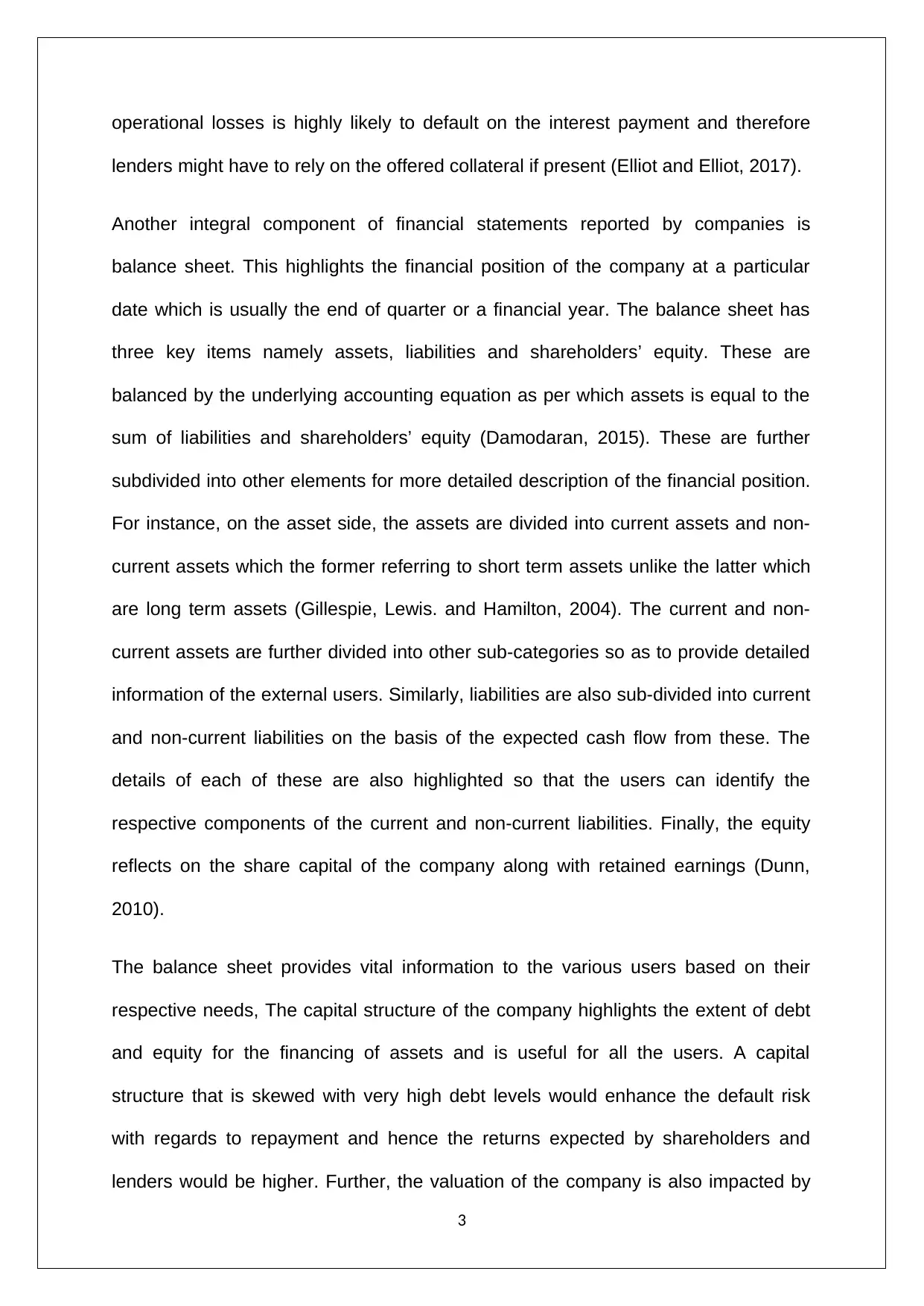
operational losses is highly likely to default on the interest payment and therefore
lenders might have to rely on the offered collateral if present (Elliot and Elliot, 2017).
Another integral component of financial statements reported by companies is
balance sheet. This highlights the financial position of the company at a particular
date which is usually the end of quarter or a financial year. The balance sheet has
three key items namely assets, liabilities and shareholders’ equity. These are
balanced by the underlying accounting equation as per which assets is equal to the
sum of liabilities and shareholders’ equity (Damodaran, 2015). These are further
subdivided into other elements for more detailed description of the financial position.
For instance, on the asset side, the assets are divided into current assets and non-
current assets which the former referring to short term assets unlike the latter which
are long term assets (Gillespie, Lewis. and Hamilton, 2004). The current and non-
current assets are further divided into other sub-categories so as to provide detailed
information of the external users. Similarly, liabilities are also sub-divided into current
and non-current liabilities on the basis of the expected cash flow from these. The
details of each of these are also highlighted so that the users can identify the
respective components of the current and non-current liabilities. Finally, the equity
reflects on the share capital of the company along with retained earnings (Dunn,
2010).
The balance sheet provides vital information to the various users based on their
respective needs, The capital structure of the company highlights the extent of debt
and equity for the financing of assets and is useful for all the users. A capital
structure that is skewed with very high debt levels would enhance the default risk
with regards to repayment and hence the returns expected by shareholders and
lenders would be higher. Further, the valuation of the company is also impacted by
3
lenders might have to rely on the offered collateral if present (Elliot and Elliot, 2017).
Another integral component of financial statements reported by companies is
balance sheet. This highlights the financial position of the company at a particular
date which is usually the end of quarter or a financial year. The balance sheet has
three key items namely assets, liabilities and shareholders’ equity. These are
balanced by the underlying accounting equation as per which assets is equal to the
sum of liabilities and shareholders’ equity (Damodaran, 2015). These are further
subdivided into other elements for more detailed description of the financial position.
For instance, on the asset side, the assets are divided into current assets and non-
current assets which the former referring to short term assets unlike the latter which
are long term assets (Gillespie, Lewis. and Hamilton, 2004). The current and non-
current assets are further divided into other sub-categories so as to provide detailed
information of the external users. Similarly, liabilities are also sub-divided into current
and non-current liabilities on the basis of the expected cash flow from these. The
details of each of these are also highlighted so that the users can identify the
respective components of the current and non-current liabilities. Finally, the equity
reflects on the share capital of the company along with retained earnings (Dunn,
2010).
The balance sheet provides vital information to the various users based on their
respective needs, The capital structure of the company highlights the extent of debt
and equity for the financing of assets and is useful for all the users. A capital
structure that is skewed with very high debt levels would enhance the default risk
with regards to repayment and hence the returns expected by shareholders and
lenders would be higher. Further, the valuation of the company is also impacted by
3
Paraphrase This Document
Need a fresh take? Get an instant paraphrase of this document with our AI Paraphraser
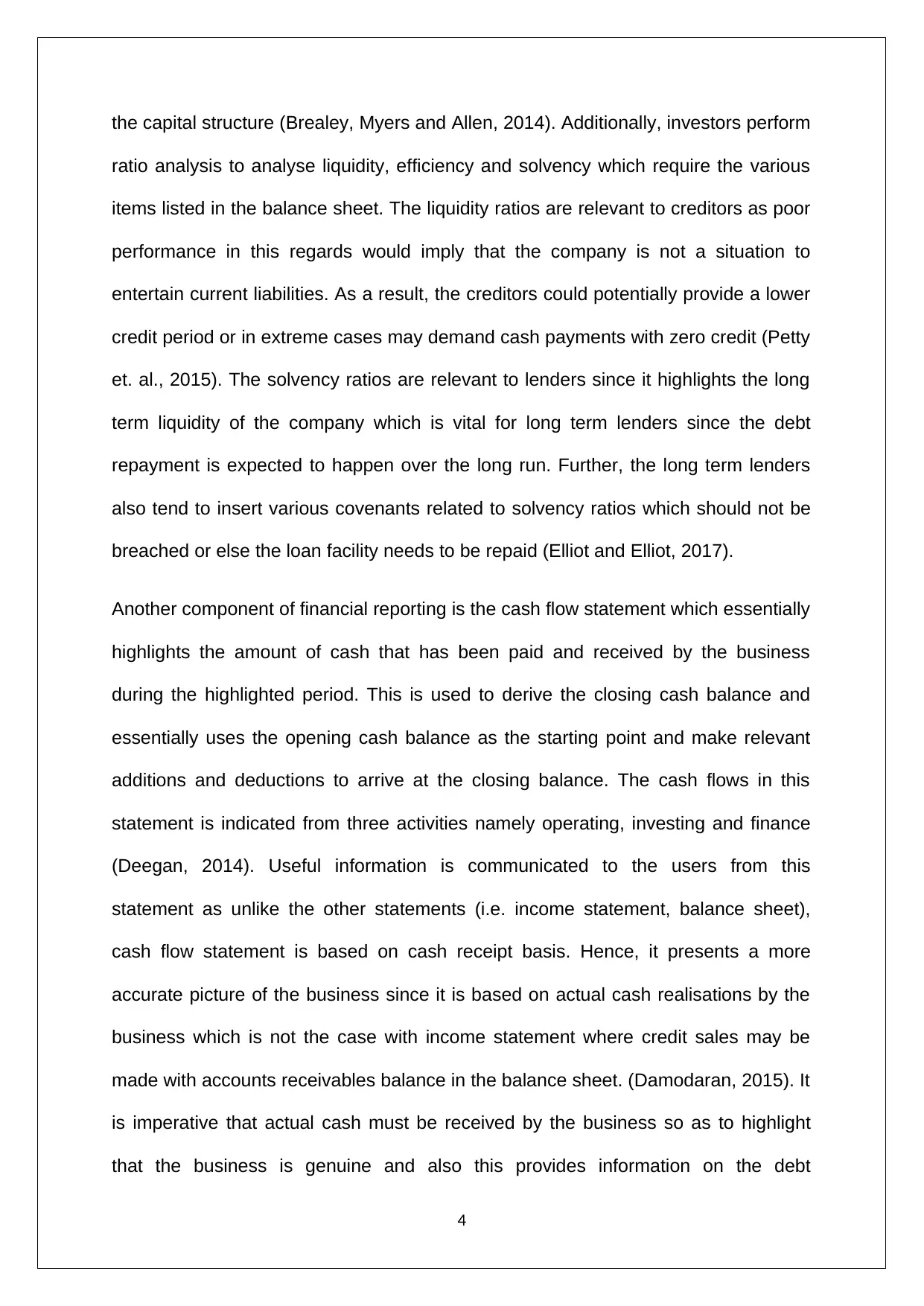
the capital structure (Brealey, Myers and Allen, 2014). Additionally, investors perform
ratio analysis to analyse liquidity, efficiency and solvency which require the various
items listed in the balance sheet. The liquidity ratios are relevant to creditors as poor
performance in this regards would imply that the company is not a situation to
entertain current liabilities. As a result, the creditors could potentially provide a lower
credit period or in extreme cases may demand cash payments with zero credit (Petty
et. al., 2015). The solvency ratios are relevant to lenders since it highlights the long
term liquidity of the company which is vital for long term lenders since the debt
repayment is expected to happen over the long run. Further, the long term lenders
also tend to insert various covenants related to solvency ratios which should not be
breached or else the loan facility needs to be repaid (Elliot and Elliot, 2017).
Another component of financial reporting is the cash flow statement which essentially
highlights the amount of cash that has been paid and received by the business
during the highlighted period. This is used to derive the closing cash balance and
essentially uses the opening cash balance as the starting point and make relevant
additions and deductions to arrive at the closing balance. The cash flows in this
statement is indicated from three activities namely operating, investing and finance
(Deegan, 2014). Useful information is communicated to the users from this
statement as unlike the other statements (i.e. income statement, balance sheet),
cash flow statement is based on cash receipt basis. Hence, it presents a more
accurate picture of the business since it is based on actual cash realisations by the
business which is not the case with income statement where credit sales may be
made with accounts receivables balance in the balance sheet. (Damodaran, 2015). It
is imperative that actual cash must be received by the business so as to highlight
that the business is genuine and also this provides information on the debt
4
ratio analysis to analyse liquidity, efficiency and solvency which require the various
items listed in the balance sheet. The liquidity ratios are relevant to creditors as poor
performance in this regards would imply that the company is not a situation to
entertain current liabilities. As a result, the creditors could potentially provide a lower
credit period or in extreme cases may demand cash payments with zero credit (Petty
et. al., 2015). The solvency ratios are relevant to lenders since it highlights the long
term liquidity of the company which is vital for long term lenders since the debt
repayment is expected to happen over the long run. Further, the long term lenders
also tend to insert various covenants related to solvency ratios which should not be
breached or else the loan facility needs to be repaid (Elliot and Elliot, 2017).
Another component of financial reporting is the cash flow statement which essentially
highlights the amount of cash that has been paid and received by the business
during the highlighted period. This is used to derive the closing cash balance and
essentially uses the opening cash balance as the starting point and make relevant
additions and deductions to arrive at the closing balance. The cash flows in this
statement is indicated from three activities namely operating, investing and finance
(Deegan, 2014). Useful information is communicated to the users from this
statement as unlike the other statements (i.e. income statement, balance sheet),
cash flow statement is based on cash receipt basis. Hence, it presents a more
accurate picture of the business since it is based on actual cash realisations by the
business which is not the case with income statement where credit sales may be
made with accounts receivables balance in the balance sheet. (Damodaran, 2015). It
is imperative that actual cash must be received by the business so as to highlight
that the business is genuine and also this provides information on the debt
4
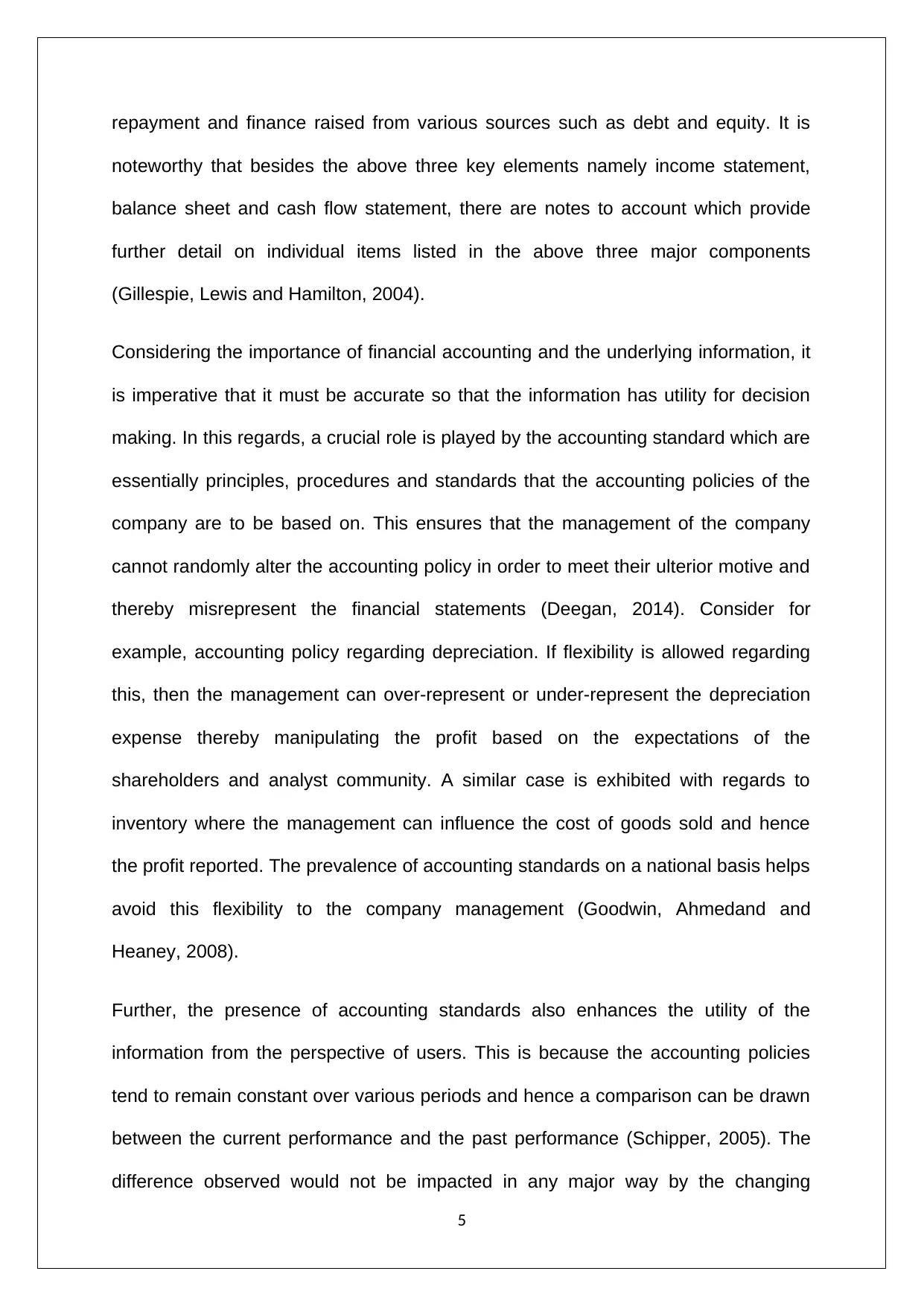
repayment and finance raised from various sources such as debt and equity. It is
noteworthy that besides the above three key elements namely income statement,
balance sheet and cash flow statement, there are notes to account which provide
further detail on individual items listed in the above three major components
(Gillespie, Lewis and Hamilton, 2004).
Considering the importance of financial accounting and the underlying information, it
is imperative that it must be accurate so that the information has utility for decision
making. In this regards, a crucial role is played by the accounting standard which are
essentially principles, procedures and standards that the accounting policies of the
company are to be based on. This ensures that the management of the company
cannot randomly alter the accounting policy in order to meet their ulterior motive and
thereby misrepresent the financial statements (Deegan, 2014). Consider for
example, accounting policy regarding depreciation. If flexibility is allowed regarding
this, then the management can over-represent or under-represent the depreciation
expense thereby manipulating the profit based on the expectations of the
shareholders and analyst community. A similar case is exhibited with regards to
inventory where the management can influence the cost of goods sold and hence
the profit reported. The prevalence of accounting standards on a national basis helps
avoid this flexibility to the company management (Goodwin, Ahmedand and
Heaney, 2008).
Further, the presence of accounting standards also enhances the utility of the
information from the perspective of users. This is because the accounting policies
tend to remain constant over various periods and hence a comparison can be drawn
between the current performance and the past performance (Schipper, 2005). The
difference observed would not be impacted in any major way by the changing
5
noteworthy that besides the above three key elements namely income statement,
balance sheet and cash flow statement, there are notes to account which provide
further detail on individual items listed in the above three major components
(Gillespie, Lewis and Hamilton, 2004).
Considering the importance of financial accounting and the underlying information, it
is imperative that it must be accurate so that the information has utility for decision
making. In this regards, a crucial role is played by the accounting standard which are
essentially principles, procedures and standards that the accounting policies of the
company are to be based on. This ensures that the management of the company
cannot randomly alter the accounting policy in order to meet their ulterior motive and
thereby misrepresent the financial statements (Deegan, 2014). Consider for
example, accounting policy regarding depreciation. If flexibility is allowed regarding
this, then the management can over-represent or under-represent the depreciation
expense thereby manipulating the profit based on the expectations of the
shareholders and analyst community. A similar case is exhibited with regards to
inventory where the management can influence the cost of goods sold and hence
the profit reported. The prevalence of accounting standards on a national basis helps
avoid this flexibility to the company management (Goodwin, Ahmedand and
Heaney, 2008).
Further, the presence of accounting standards also enhances the utility of the
information from the perspective of users. This is because the accounting policies
tend to remain constant over various periods and hence a comparison can be drawn
between the current performance and the past performance (Schipper, 2005). The
difference observed would not be impacted in any major way by the changing
5
⊘ This is a preview!⊘
Do you want full access?
Subscribe today to unlock all pages.

Trusted by 1+ million students worldwide
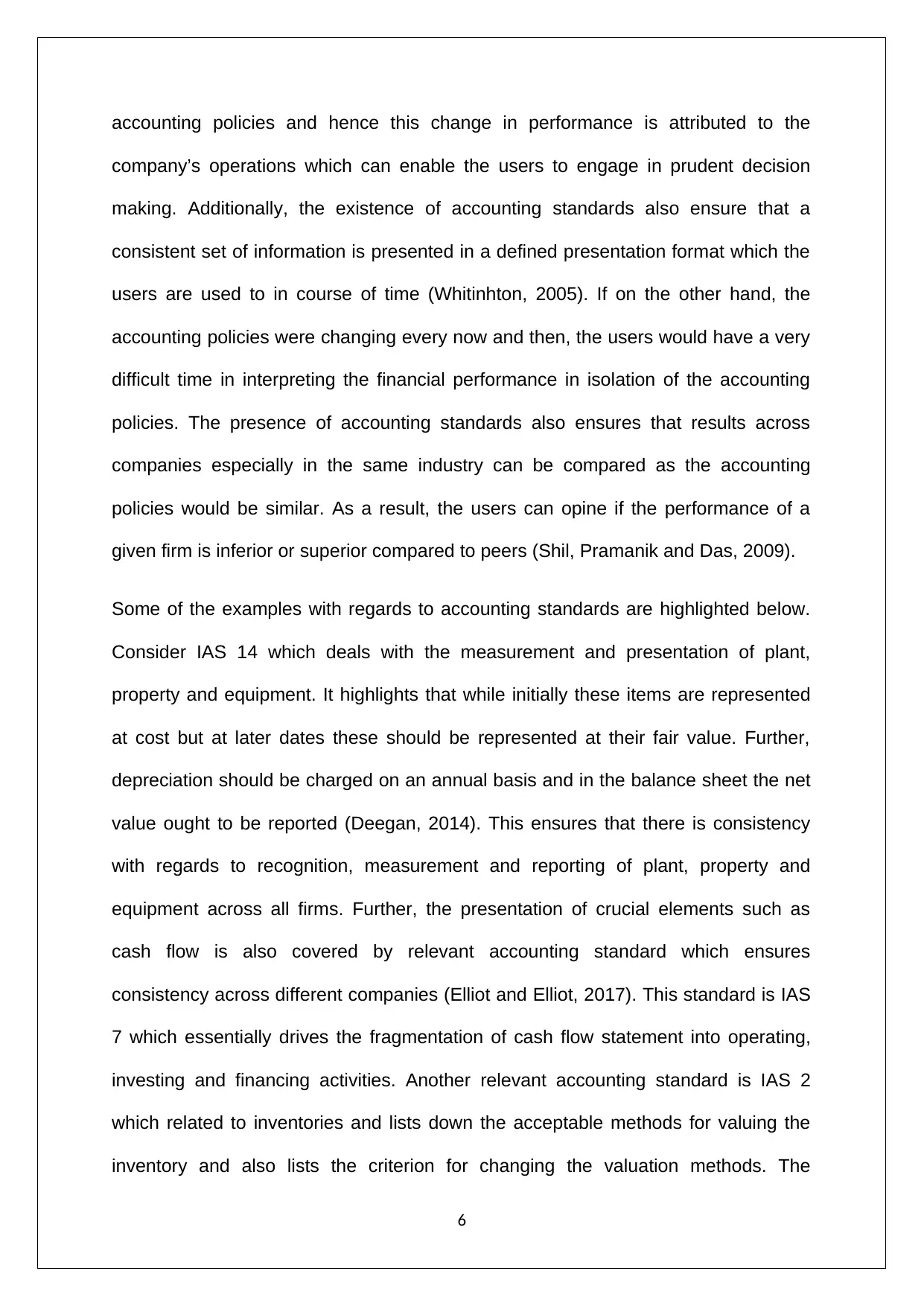
accounting policies and hence this change in performance is attributed to the
company’s operations which can enable the users to engage in prudent decision
making. Additionally, the existence of accounting standards also ensure that a
consistent set of information is presented in a defined presentation format which the
users are used to in course of time (Whitinhton, 2005). If on the other hand, the
accounting policies were changing every now and then, the users would have a very
difficult time in interpreting the financial performance in isolation of the accounting
policies. The presence of accounting standards also ensures that results across
companies especially in the same industry can be compared as the accounting
policies would be similar. As a result, the users can opine if the performance of a
given firm is inferior or superior compared to peers (Shil, Pramanik and Das, 2009).
Some of the examples with regards to accounting standards are highlighted below.
Consider IAS 14 which deals with the measurement and presentation of plant,
property and equipment. It highlights that while initially these items are represented
at cost but at later dates these should be represented at their fair value. Further,
depreciation should be charged on an annual basis and in the balance sheet the net
value ought to be reported (Deegan, 2014). This ensures that there is consistency
with regards to recognition, measurement and reporting of plant, property and
equipment across all firms. Further, the presentation of crucial elements such as
cash flow is also covered by relevant accounting standard which ensures
consistency across different companies (Elliot and Elliot, 2017). This standard is IAS
7 which essentially drives the fragmentation of cash flow statement into operating,
investing and financing activities. Another relevant accounting standard is IAS 2
which related to inventories and lists down the acceptable methods for valuing the
inventory and also lists the criterion for changing the valuation methods. The
6
company’s operations which can enable the users to engage in prudent decision
making. Additionally, the existence of accounting standards also ensure that a
consistent set of information is presented in a defined presentation format which the
users are used to in course of time (Whitinhton, 2005). If on the other hand, the
accounting policies were changing every now and then, the users would have a very
difficult time in interpreting the financial performance in isolation of the accounting
policies. The presence of accounting standards also ensures that results across
companies especially in the same industry can be compared as the accounting
policies would be similar. As a result, the users can opine if the performance of a
given firm is inferior or superior compared to peers (Shil, Pramanik and Das, 2009).
Some of the examples with regards to accounting standards are highlighted below.
Consider IAS 14 which deals with the measurement and presentation of plant,
property and equipment. It highlights that while initially these items are represented
at cost but at later dates these should be represented at their fair value. Further,
depreciation should be charged on an annual basis and in the balance sheet the net
value ought to be reported (Deegan, 2014). This ensures that there is consistency
with regards to recognition, measurement and reporting of plant, property and
equipment across all firms. Further, the presentation of crucial elements such as
cash flow is also covered by relevant accounting standard which ensures
consistency across different companies (Elliot and Elliot, 2017). This standard is IAS
7 which essentially drives the fragmentation of cash flow statement into operating,
investing and financing activities. Another relevant accounting standard is IAS 2
which related to inventories and lists down the acceptable methods for valuing the
inventory and also lists the criterion for changing the valuation methods. The
6
Paraphrase This Document
Need a fresh take? Get an instant paraphrase of this document with our AI Paraphraser
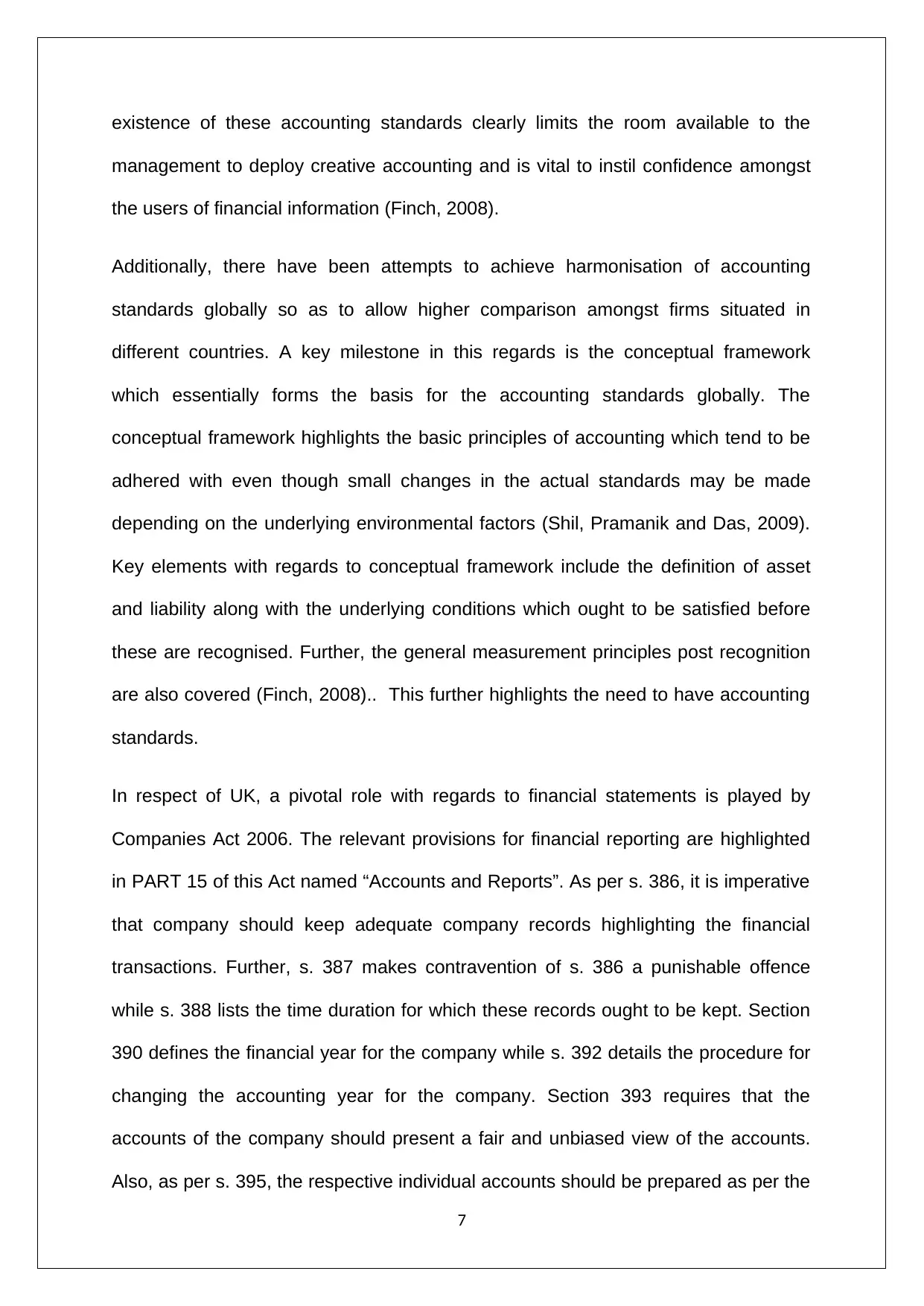
existence of these accounting standards clearly limits the room available to the
management to deploy creative accounting and is vital to instil confidence amongst
the users of financial information (Finch, 2008).
Additionally, there have been attempts to achieve harmonisation of accounting
standards globally so as to allow higher comparison amongst firms situated in
different countries. A key milestone in this regards is the conceptual framework
which essentially forms the basis for the accounting standards globally. The
conceptual framework highlights the basic principles of accounting which tend to be
adhered with even though small changes in the actual standards may be made
depending on the underlying environmental factors (Shil, Pramanik and Das, 2009).
Key elements with regards to conceptual framework include the definition of asset
and liability along with the underlying conditions which ought to be satisfied before
these are recognised. Further, the general measurement principles post recognition
are also covered (Finch, 2008).. This further highlights the need to have accounting
standards.
In respect of UK, a pivotal role with regards to financial statements is played by
Companies Act 2006. The relevant provisions for financial reporting are highlighted
in PART 15 of this Act named “Accounts and Reports”. As per s. 386, it is imperative
that company should keep adequate company records highlighting the financial
transactions. Further, s. 387 makes contravention of s. 386 a punishable offence
while s. 388 lists the time duration for which these records ought to be kept. Section
390 defines the financial year for the company while s. 392 details the procedure for
changing the accounting year for the company. Section 393 requires that the
accounts of the company should present a fair and unbiased view of the accounts.
Also, as per s. 395, the respective individual accounts should be prepared as per the
7
management to deploy creative accounting and is vital to instil confidence amongst
the users of financial information (Finch, 2008).
Additionally, there have been attempts to achieve harmonisation of accounting
standards globally so as to allow higher comparison amongst firms situated in
different countries. A key milestone in this regards is the conceptual framework
which essentially forms the basis for the accounting standards globally. The
conceptual framework highlights the basic principles of accounting which tend to be
adhered with even though small changes in the actual standards may be made
depending on the underlying environmental factors (Shil, Pramanik and Das, 2009).
Key elements with regards to conceptual framework include the definition of asset
and liability along with the underlying conditions which ought to be satisfied before
these are recognised. Further, the general measurement principles post recognition
are also covered (Finch, 2008).. This further highlights the need to have accounting
standards.
In respect of UK, a pivotal role with regards to financial statements is played by
Companies Act 2006. The relevant provisions for financial reporting are highlighted
in PART 15 of this Act named “Accounts and Reports”. As per s. 386, it is imperative
that company should keep adequate company records highlighting the financial
transactions. Further, s. 387 makes contravention of s. 386 a punishable offence
while s. 388 lists the time duration for which these records ought to be kept. Section
390 defines the financial year for the company while s. 392 details the procedure for
changing the accounting year for the company. Section 393 requires that the
accounts of the company should present a fair and unbiased view of the accounts.
Also, as per s. 395, the respective individual accounts should be prepared as per the
7
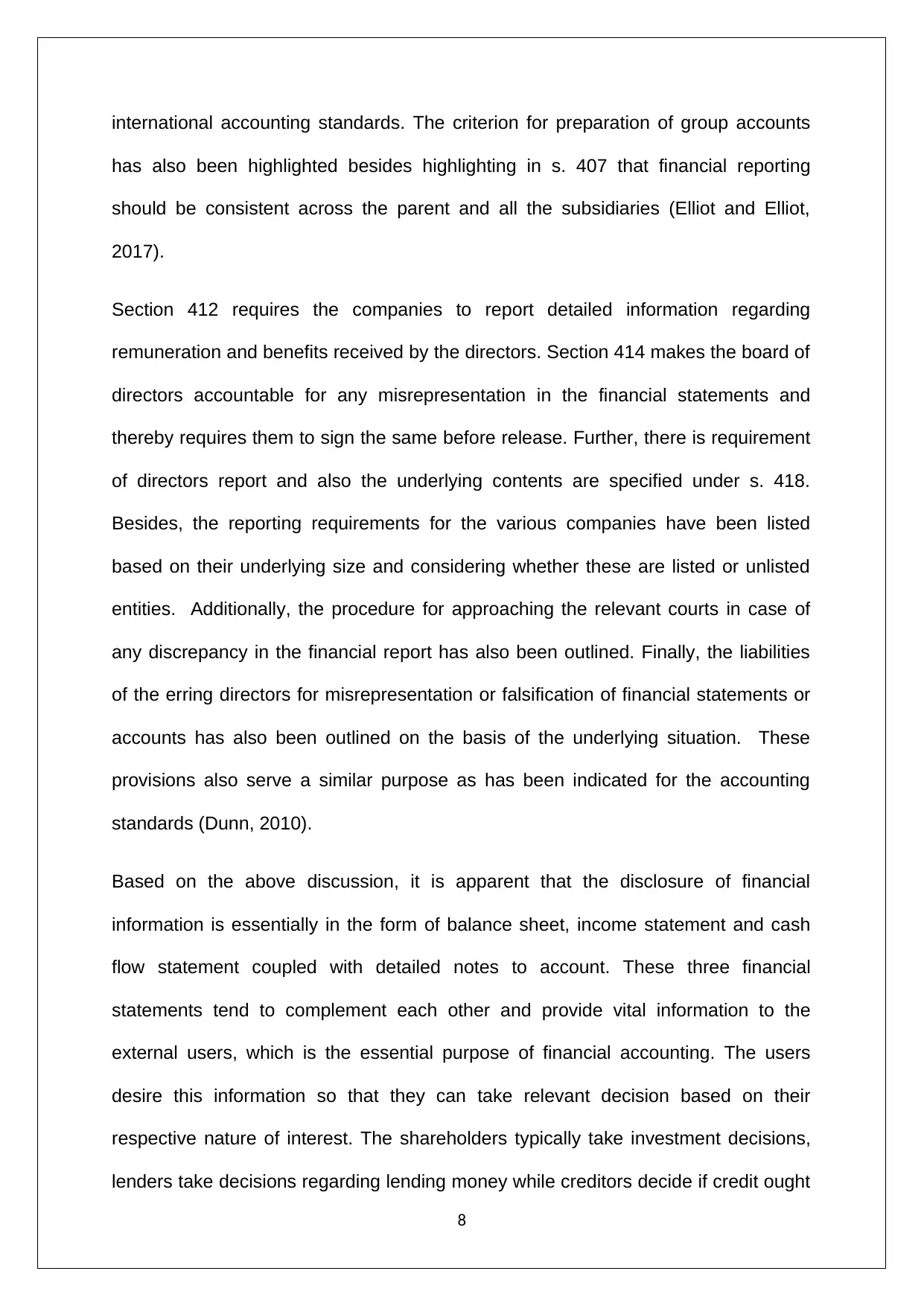
international accounting standards. The criterion for preparation of group accounts
has also been highlighted besides highlighting in s. 407 that financial reporting
should be consistent across the parent and all the subsidiaries (Elliot and Elliot,
2017).
Section 412 requires the companies to report detailed information regarding
remuneration and benefits received by the directors. Section 414 makes the board of
directors accountable for any misrepresentation in the financial statements and
thereby requires them to sign the same before release. Further, there is requirement
of directors report and also the underlying contents are specified under s. 418.
Besides, the reporting requirements for the various companies have been listed
based on their underlying size and considering whether these are listed or unlisted
entities. Additionally, the procedure for approaching the relevant courts in case of
any discrepancy in the financial report has also been outlined. Finally, the liabilities
of the erring directors for misrepresentation or falsification of financial statements or
accounts has also been outlined on the basis of the underlying situation. These
provisions also serve a similar purpose as has been indicated for the accounting
standards (Dunn, 2010).
Based on the above discussion, it is apparent that the disclosure of financial
information is essentially in the form of balance sheet, income statement and cash
flow statement coupled with detailed notes to account. These three financial
statements tend to complement each other and provide vital information to the
external users, which is the essential purpose of financial accounting. The users
desire this information so that they can take relevant decision based on their
respective nature of interest. The shareholders typically take investment decisions,
lenders take decisions regarding lending money while creditors decide if credit ought
8
has also been highlighted besides highlighting in s. 407 that financial reporting
should be consistent across the parent and all the subsidiaries (Elliot and Elliot,
2017).
Section 412 requires the companies to report detailed information regarding
remuneration and benefits received by the directors. Section 414 makes the board of
directors accountable for any misrepresentation in the financial statements and
thereby requires them to sign the same before release. Further, there is requirement
of directors report and also the underlying contents are specified under s. 418.
Besides, the reporting requirements for the various companies have been listed
based on their underlying size and considering whether these are listed or unlisted
entities. Additionally, the procedure for approaching the relevant courts in case of
any discrepancy in the financial report has also been outlined. Finally, the liabilities
of the erring directors for misrepresentation or falsification of financial statements or
accounts has also been outlined on the basis of the underlying situation. These
provisions also serve a similar purpose as has been indicated for the accounting
standards (Dunn, 2010).
Based on the above discussion, it is apparent that the disclosure of financial
information is essentially in the form of balance sheet, income statement and cash
flow statement coupled with detailed notes to account. These three financial
statements tend to complement each other and provide vital information to the
external users, which is the essential purpose of financial accounting. The users
desire this information so that they can take relevant decision based on their
respective nature of interest. The shareholders typically take investment decisions,
lenders take decisions regarding lending money while creditors decide if credit ought
8
⊘ This is a preview!⊘
Do you want full access?
Subscribe today to unlock all pages.

Trusted by 1+ million students worldwide
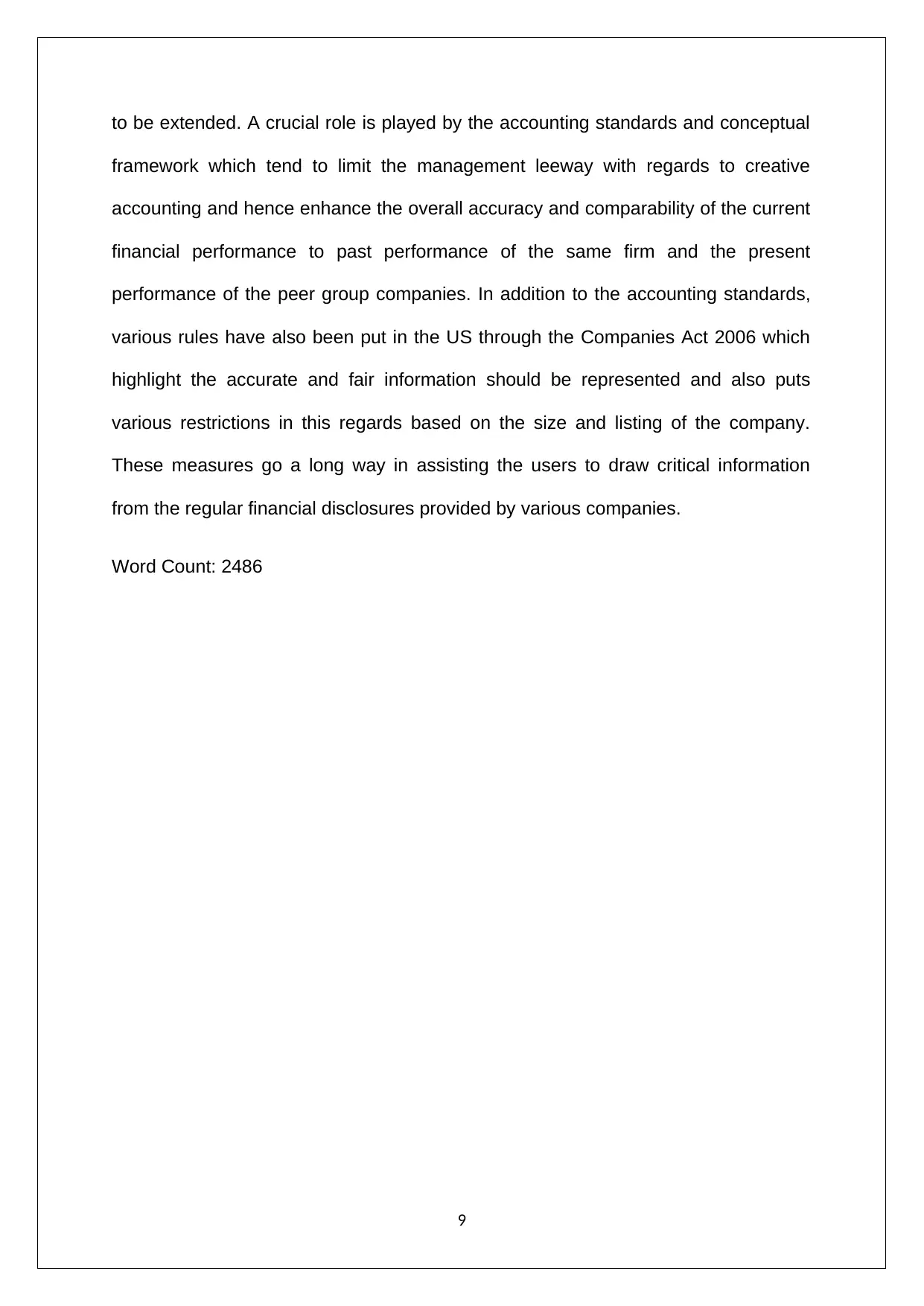
to be extended. A crucial role is played by the accounting standards and conceptual
framework which tend to limit the management leeway with regards to creative
accounting and hence enhance the overall accuracy and comparability of the current
financial performance to past performance of the same firm and the present
performance of the peer group companies. In addition to the accounting standards,
various rules have also been put in the US through the Companies Act 2006 which
highlight the accurate and fair information should be represented and also puts
various restrictions in this regards based on the size and listing of the company.
These measures go a long way in assisting the users to draw critical information
from the regular financial disclosures provided by various companies.
Word Count: 2486
9
framework which tend to limit the management leeway with regards to creative
accounting and hence enhance the overall accuracy and comparability of the current
financial performance to past performance of the same firm and the present
performance of the peer group companies. In addition to the accounting standards,
various rules have also been put in the US through the Companies Act 2006 which
highlight the accurate and fair information should be represented and also puts
various restrictions in this regards based on the size and listing of the company.
These measures go a long way in assisting the users to draw critical information
from the regular financial disclosures provided by various companies.
Word Count: 2486
9
Paraphrase This Document
Need a fresh take? Get an instant paraphrase of this document with our AI Paraphraser
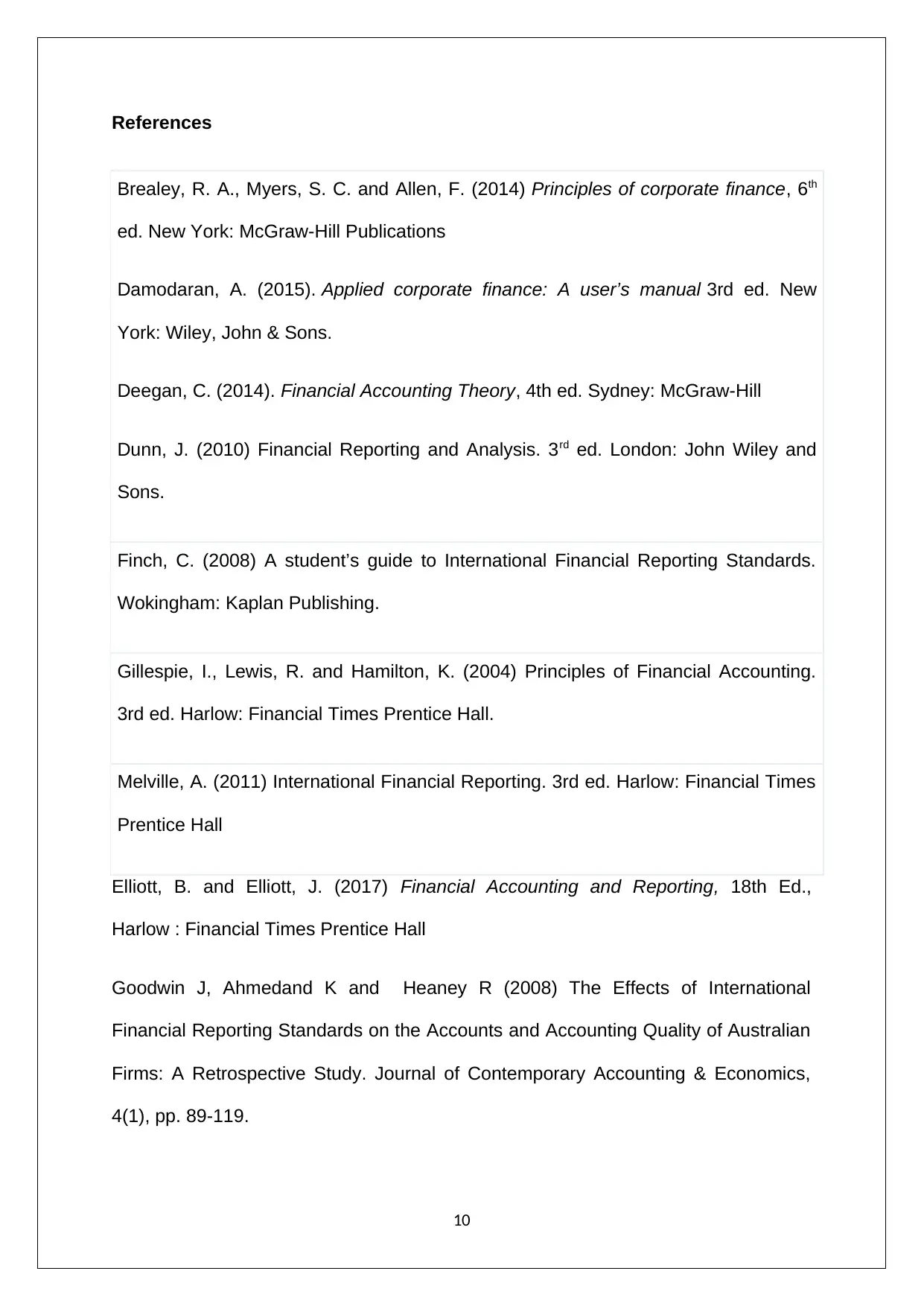
References
Brealey, R. A., Myers, S. C. and Allen, F. (2014) Principles of corporate finance, 6th
ed. New York: McGraw-Hill Publications
Damodaran, A. (2015). Applied corporate finance: A user’s manual 3rd ed. New
York: Wiley, John & Sons.
Deegan, C. (2014). Financial Accounting Theory, 4th ed. Sydney: McGraw-Hill
Dunn, J. (2010) Financial Reporting and Analysis. 3rd ed. London: John Wiley and
Sons.
Finch, C. (2008) A student’s guide to International Financial Reporting Standards.
Wokingham: Kaplan Publishing.
Gillespie, I., Lewis, R. and Hamilton, K. (2004) Principles of Financial Accounting.
3rd ed. Harlow: Financial Times Prentice Hall.
Melville, A. (2011) International Financial Reporting. 3rd ed. Harlow: Financial Times
Prentice Hall
Elliott, B. and Elliott, J. (2017) Financial Accounting and Reporting, 18th Ed.,
Harlow : Financial Times Prentice Hall
Goodwin J, Ahmedand K and Heaney R (2008) The Effects of International
Financial Reporting Standards on the Accounts and Accounting Quality of Australian
Firms: A Retrospective Study. Journal of Contemporary Accounting & Economics,
4(1), pp. 89-119.
10
Brealey, R. A., Myers, S. C. and Allen, F. (2014) Principles of corporate finance, 6th
ed. New York: McGraw-Hill Publications
Damodaran, A. (2015). Applied corporate finance: A user’s manual 3rd ed. New
York: Wiley, John & Sons.
Deegan, C. (2014). Financial Accounting Theory, 4th ed. Sydney: McGraw-Hill
Dunn, J. (2010) Financial Reporting and Analysis. 3rd ed. London: John Wiley and
Sons.
Finch, C. (2008) A student’s guide to International Financial Reporting Standards.
Wokingham: Kaplan Publishing.
Gillespie, I., Lewis, R. and Hamilton, K. (2004) Principles of Financial Accounting.
3rd ed. Harlow: Financial Times Prentice Hall.
Melville, A. (2011) International Financial Reporting. 3rd ed. Harlow: Financial Times
Prentice Hall
Elliott, B. and Elliott, J. (2017) Financial Accounting and Reporting, 18th Ed.,
Harlow : Financial Times Prentice Hall
Goodwin J, Ahmedand K and Heaney R (2008) The Effects of International
Financial Reporting Standards on the Accounts and Accounting Quality of Australian
Firms: A Retrospective Study. Journal of Contemporary Accounting & Economics,
4(1), pp. 89-119.
10
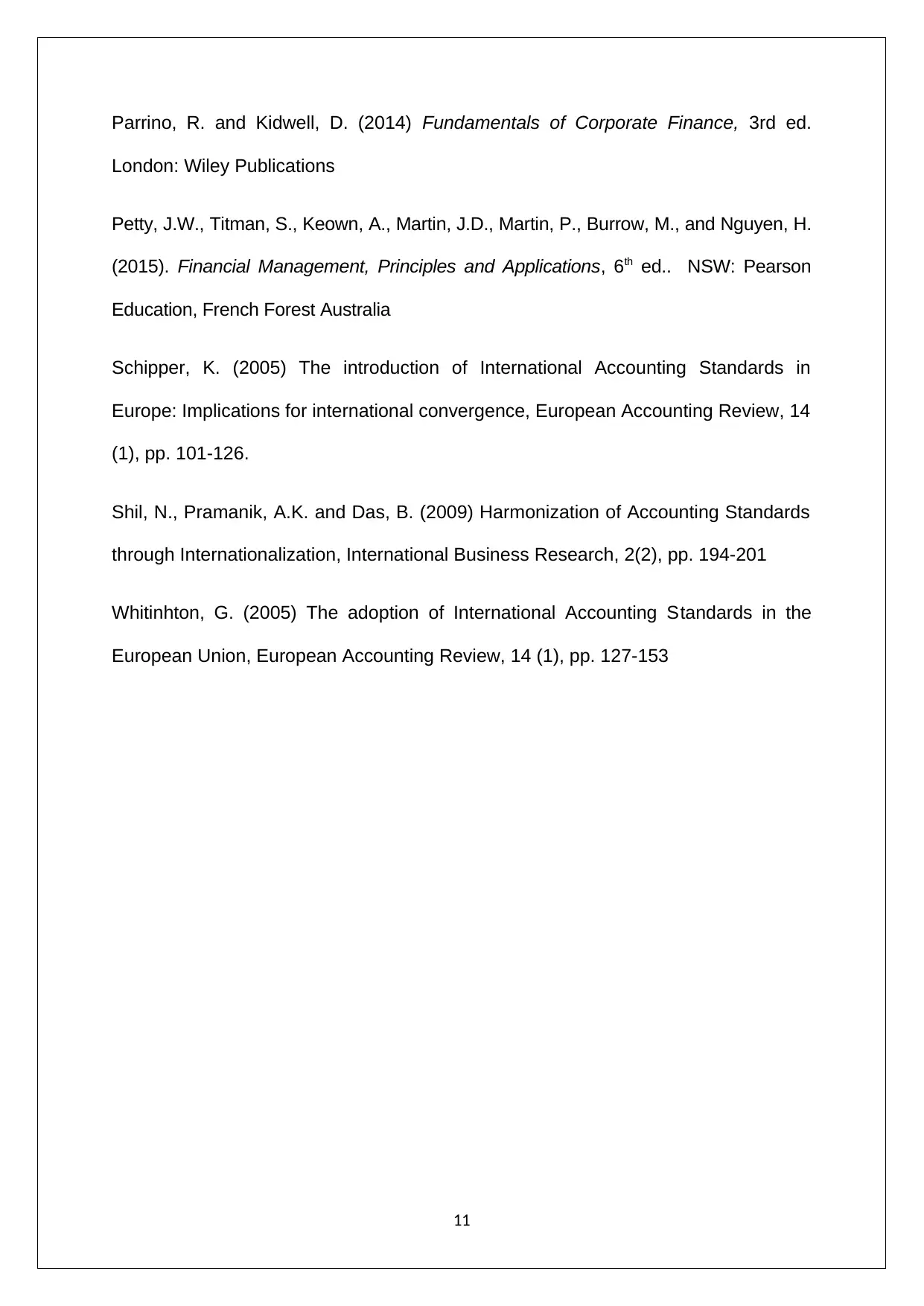
Parrino, R. and Kidwell, D. (2014) Fundamentals of Corporate Finance, 3rd ed.
London: Wiley Publications
Petty, J.W., Titman, S., Keown, A., Martin, J.D., Martin, P., Burrow, M., and Nguyen, H.
(2015). Financial Management, Principles and Applications, 6th ed.. NSW: Pearson
Education, French Forest Australia
Schipper, K. (2005) The introduction of International Accounting Standards in
Europe: Implications for international convergence, European Accounting Review, 14
(1), pp. 101-126.
Shil, N., Pramanik, A.K. and Das, B. (2009) Harmonization of Accounting Standards
through Internationalization, International Business Research, 2(2), pp. 194-201
Whitinhton, G. (2005) The adoption of International Accounting Standards in the
European Union, European Accounting Review, 14 (1), pp. 127-153
11
London: Wiley Publications
Petty, J.W., Titman, S., Keown, A., Martin, J.D., Martin, P., Burrow, M., and Nguyen, H.
(2015). Financial Management, Principles and Applications, 6th ed.. NSW: Pearson
Education, French Forest Australia
Schipper, K. (2005) The introduction of International Accounting Standards in
Europe: Implications for international convergence, European Accounting Review, 14
(1), pp. 101-126.
Shil, N., Pramanik, A.K. and Das, B. (2009) Harmonization of Accounting Standards
through Internationalization, International Business Research, 2(2), pp. 194-201
Whitinhton, G. (2005) The adoption of International Accounting Standards in the
European Union, European Accounting Review, 14 (1), pp. 127-153
11
⊘ This is a preview!⊘
Do you want full access?
Subscribe today to unlock all pages.

Trusted by 1+ million students worldwide
1 out of 12
Related Documents
Your All-in-One AI-Powered Toolkit for Academic Success.
+13062052269
info@desklib.com
Available 24*7 on WhatsApp / Email
![[object Object]](/_next/static/media/star-bottom.7253800d.svg)
Unlock your academic potential
Copyright © 2020–2025 A2Z Services. All Rights Reserved. Developed and managed by ZUCOL.





